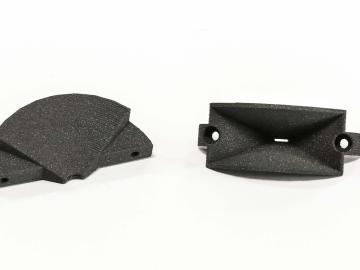
Filter News
Area of Research
- (-) Advanced Manufacturing (14)
- (-) Sensors and Controls (1)
- (-) Supercomputing (35)
- Biology and Environment (14)
- Building Technologies (1)
- Computational Engineering (1)
- Computer Science (6)
- Electricity and Smart Grid (2)
- Energy Science (82)
- Fusion and Fission (5)
- Fusion Energy (3)
- Isotopes (1)
- Materials (44)
- Materials for Computing (10)
- National Security (15)
- Neutron Science (14)
- Nuclear Science and Technology (7)
- Quantum information Science (1)
- Transportation Systems (1)
News Type
News Topics
- (-) 3-D Printing/Advanced Manufacturing (16)
- (-) Frontier (18)
- (-) Grid (2)
- (-) Machine Learning (9)
- (-) Materials Science (14)
- Advanced Reactors (2)
- Artificial Intelligence (23)
- Big Data (20)
- Bioenergy (3)
- Biology (7)
- Biomedical (11)
- Biotechnology (1)
- Buildings (2)
- Chemical Sciences (2)
- Composites (3)
- Computer Science (62)
- Coronavirus (9)
- Critical Materials (3)
- Cybersecurity (2)
- Energy Storage (2)
- Environment (18)
- Exascale Computing (17)
- Fusion (2)
- High-Performance Computing (28)
- Isotopes (1)
- Materials (11)
- Mathematics (2)
- Microscopy (2)
- Nanotechnology (6)
- National Security (3)
- Neutron Science (8)
- Nuclear Energy (4)
- Physics (4)
- Polymers (2)
- Quantum Computing (15)
- Quantum Science (14)
- Security (2)
- Simulation (13)
- Software (1)
- Space Exploration (3)
- Summit (28)
- Transportation (4)
Media Contacts

Oak Ridge National Laboratory researchers combined additive manufacturing with conventional compression molding to produce high-performance thermoplastic composites reinforced with short carbon fibers.

A team of Oak Ridge National Laboratory researchers demonstrated that an additively manufactured hot stamping die – a tool used to create car body components – cooled faster than those produced by conventional manufacturing methods.

A method developed at Oak Ridge National Laboratory to print high-fidelity, passive sensors for energy applications can reduce the cost of monitoring critical power grid assets.

Twenty-seven ORNL researchers Zoomed into 11 middle schools across Tennessee during the annual Engineers Week in February. East Tennessee schools throughout Oak Ridge and Roane, Sevier, Blount and Loudon counties participated, with three West Tennessee schools joining in.

Oak Ridge National Laboratory researchers have demonstrated that a new class of superalloys made of cobalt and nickel remains crack-free and defect-resistant in extreme heat, making them conducive for use in metal-based 3D printing applications.

The ExOne Company, the global leader in industrial sand and metal 3D printers using binder jetting technology, announced it has reached a commercial license agreement with Oak Ridge National Laboratory to 3D print parts in aluminum-infiltrated boron carbide.

Oak Ridge National Laboratory scientists have discovered a cost-effective way to significantly improve the mechanical performance of common polymer nanocomposite materials.

ORNL researchers have developed an intelligent power electronic inverter platform that can connect locally sited energy resources such as solar panels, energy storage and electric vehicles and smoothly interact with the utility power grid.

From materials science and earth system modeling to quantum information science and cybersecurity, experts in many fields run simulations and conduct experiments to collect the abundance of data necessary for scientific progress.

Scientists have tapped the immense power of the Summit supercomputer at Oak Ridge National Laboratory to comb through millions of medical journal articles to identify potential vaccines, drugs and effective measures that could suppress or stop the


